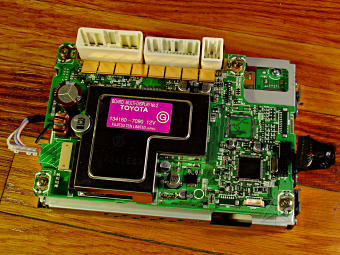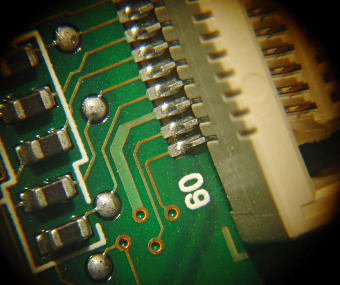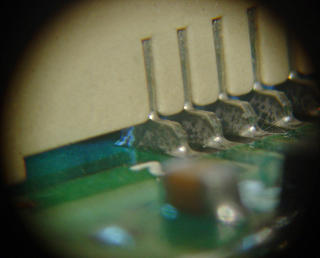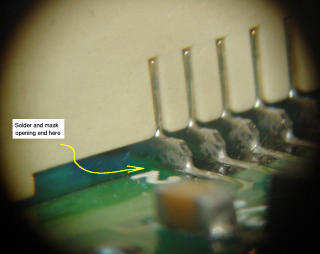[Each picture is linked to a larger copy.]
For completeness, I decided to take my own still-functional unit apart to see if I could spot any differences in manufacturing that may have addressed the connector-flakiness problem to make the later cars' displays more reliable.

The only difference visible here is that my unit has a "G" in a circle on the pink label. Underneath, some long part number in the white paint also contains a "G" where the other MFD has "F". That would imply a revision difference.

Looks like the same connector is used. There aren't any visible maker or part numbers on the connector so I don't even know who makes this one -- it may be underneath, entombed forever against the board. Here we can sort of see the inverted "U" shaped lead-in pieces that can flex to allow the center part of the shell to float around a little. The outer ends of those emerge as the surface-mount terminals down below.

Through the microscope, the soldering looks a little cleaner and more uniform, but there is also less of the conformal coating splashed in against the connector so it may just look better cosmetically. But the surface-tension fillets seem a little tighter than on the failed unit, which may indicate slightly changed solder reflow parameters.
One thing to keep in mind that between 2004 and 2008 or so, we're in the middle of the big RoHS changeover nightmare. New types of lead-free solder need slightly higher temperatures to flow, and component plastics and circuit board materials must be sufficiently heat-resistant to survive the automated soldering process. The industry has experienced a lot of pain while re- engineering its assembly lines, producing a few short-lived products that die due to cold or cracked joints, tin whisker growth, hidden component damage, moist-air surface corrosion, and who knows what else -- all because of the concerns about lead and some other materials reaching the environment in discarded electronics. [Well, maybe if consumers weren't told repeatedly that they need ANOTHER new computer or huge TV this year, this wouldn't be quite such a problem.] At this point, though, the electronics industry has mostly learned how to adapt, and suppliers are providing some better-proven materials and being able to specify how they will play together under certain heat ranges. Better studies of the effects of thermal cycling under normal use have been done as well. While researching some of this as background for what might be generically wrong with the MFD, I ran across some good references to round out what I was vaguely groping for as potential reliability issues. http://www.globalsmt.net/content/view/967/118/ is entitled "Enhancing Pb-free Solder Joint Reliability", and discusses some of the techniques that can be used to mitigate stress issues in surface-mount parts and connections. http://www.apec-conf.org/2006/APEC_2006_SP4_5.pdf is a set of slides about the effects of RoHS compliance changes on components and supplies. Page 19 shows two amusing failure modes. Parts have gotten so small that solder surface tension is a big issue, and if a board becomes too hot during assembly the layers can crack and separate. I'm really glad the MFD failure wasn't one of the latter -- it would have been much more difficult to find, let alone fix. Google for words like "rohs", "reflow", "wetting", "smt", etc for much more. But could better process control be the whole answer to this? I'm still not convinced, and with both MFDs in front of me I can compare back and forth to try and see if the soldering is really that different, or there's any other visible characteristic that speaks to deliberate engineering improvements.

Here we're peeking way underneath that same connector on the good MFD, with an LED flashlight shining a bluer light into the top and making a visible glint off the back of the solder fillet. A nice healthy connection, from the look of it -- uniformly flowed all the way along, no cold patches, etc. Use the big pictures here to really see these details.

And finally, the same view under the bad one reveals the real change. The pad isn't long enough to extend under the entire foot of the connector lead, and the solder flow was stopped by a smaller opening in the resist mask, so only the outer part of the foot actually got tacked down. It's got about a third of the contact area that the good MFD has, in fact. The connector lead is the same, and is pretty clearly designed to be soldered all the way along with a couple of midway cavities to help wick the metal underneath -- but in the failed MFD, is severely starved for connection area. The small blue glint at the back of this one is from some of the conformal coating. Here is an enlarged side-by-side view of the difference. Interestingly, the terminals on the mating female half of the connector have slightly different shapes which extend farther out and lend themselves to longer pads, and have plenty of wetted contact area on both display boards.

Getting these shots involved an amusingly complex setup, with a "third hand" to hold the board, the tripod in *just* the right position for the camera to see down the eyepiece of the scope, *lots* of lighting, and some dumb luck on sizes of objects. Here the camera is obviously not on the tripod.
It really looks like Fujitsu Ten screwed up on those early units, and failed to design the circuit board lands to match the mounting spec for one half of the connector chosen for the purpose. The later change clearly shows that someone either knew about or rediscovered the problem, and issued a quiet ECO in the hope that the error wouldn't be noticed. The owner community certainly never heard anything about it, in contrast to, for example, the steering-shaft recall. I suppose not being able to control your cabin heat on a cold night isn't considered a "life safety" issue? In the meantime, Toyota is reaping the harvest from this error, a couple of thousand dollars at a time, every time one of these defective units finally yields to automotive-environment thermal and vibration stress and starts to fail on an out-of-warranty owner. A cost that high is even more ridiculous considering that there's nothing in this unit any more sophisticated than a modern computer motherboard, and what's that cost new, $200 or less? While the world is full of such injustices, here's one more that, when one is armed with a little knowledge, accountability for can be shifted back toward the source, or an enterprising DIYer can just work around. The remaining question now is, how long is my two-pin rework likely to last? If the crack began forming during uneven thermal stresses at manufacture, then the fix could last forever since the reflow probably relieved stress -- or since I might have mixed lead and non-lead solder, re-installation into a car could shake-n-bake it loose in six months. It could be an interesting long-term observation.